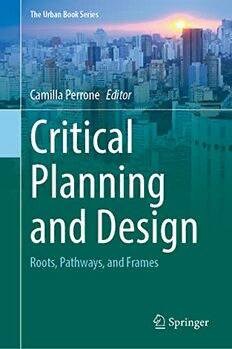Table Of ContentThe Urban Book Series
Camilla Perrone Editor
Critical
Planning
and Design
Roots, Pathways, and Frames
The Urban Book Series
EditorialBoard
MargaritaAngelidou,AristotleUniversityofThessaloniki,Thessaloniki,Greece
FatemehFarnazArefian,TheBartlettDevelopmentPlanningUnit,UCL,Silk
Cities,London,UK
MichaelBatty,CentreforAdvancedSpatialAnalysis,UCL,London,UK
SiminDavoudi,Planning&LandscapeDepartmentGURU,NewcastleUniversity,
Newcastle,UK
GeoffreyDeVerteuil,SchoolofPlanningandGeography,CardiffUniversity,
Cardiff,UK
JesúsM.GonzálezPérez,DepartmentofGeography,UniversityoftheBalearic
Islands,Palma(Mallorca),Spain
DanielB.Hess ,DepartmentofUrbanandRegionalPlanning,Universityat
Buffalo,StateUniversity,Buffalo,NY,USA
PaulJones,SchoolofArchitecture,DesignandPlanning,UniversityofSydney,
Sydney,NSW,Australia
AndrewKarvonen,DivisionofUrbanandRegionalStudies,KTHRoyalInstitute
ofTechnology,Stockholm,StockholmsLän,Sweden
AndrewKirby,NewCollege,ArizonaStateUniversity,Phoenix,AZ,USA
KarlKropf,DepartmentofPlanning,HeadingtonCampus,OxfordBrookes
University,Oxford,UK
KarenLucas,InstituteforTransportStudies,UniversityofLeeds,Leeds,UK
MarcoMaretto,DICATeA,DepartmentofCivilandEnvironmentalEngineering,
UniversityofParma,Parma,Italy
AliModarres,TacomaUrbanStudies,UniversityofWashingtonTacoma,Tacoma,
WA,USA
FabianNeuhaus,FacultyofEnvironmentalDesign,UniversityofCalgary,Calgary,
AB,Canada
SteffenNijhuis,ArchitectureandtheBuiltEnvironment,DelftUniversityof
Technology,Delft,TheNetherlands
VitorManuelAráujodeOliveira ,PortoUniversity,Porto,Portugal
ChristopherSilver,CollegeofDesign,UniversityofFlorida,Gainesville,FL,USA
GiuseppeStrappa,FacoltàdiArchitettura,SapienzaUniversityofRome,Rome,
Roma,Italy
IgorVojnovic,DepartmentofGeography,MichiganStateUniversity,EastLansing,
MI,USA
ClaudiaYamu,DepartmentofSpatialPlanningandEnvironment,Universityof
Groningen,Groningen,Groningen,TheNetherlands
QunshanZhao,SchoolofSocialandPoliticalSciences,UniversityofGlasgow,
Glasgow,UK
The Urban Book Series is a resource for urban studies and geography research
worldwide.Itprovidesauniqueandinnovativeresourceforthelatestdevelopments
in the field, nurturing a comprehensive and encompassing publication venue for
urbanstudies,urbangeography,planningandregionaldevelopment.
Theseriespublishespeer-reviewedvolumesrelatedtourbanization,sustainabil-
ity, urban environments, sustainable urbanism, governance, globalization, urban
andsustainabledevelopment,spatialandareastudies,urbanmanagement,transport
systems,urbaninfrastructure,urbandynamics,greencitiesandurbanlandscapes.It
alsoinvitesresearchwhichdocumentsurbanizationprocessesandurbandynamics
on a national, regional and local level, welcoming case studies, as well as
comparativeandappliedresearch.
Theserieswillappealtourbanists,geographers,planners,engineers,architects,
policy makers, and to all of those interested in a wide-ranging overview of
contemporary urban studies and innovations in the field. It accepts monographs,
editedvolumesandtextbooks.
IndexedbyScopus.
Moreinformationaboutthisseriesathttps://link.springer.com/bookseries/14773
Camilla Perrone
Editor
Critical Planning and Design
Roots, Pathways, and Frames
Editor
CamillaPerrone
DepartmentofArchitecture
UniversityofFlorence
Firenze,Italy
ISSN2365-757X ISSN2365-7588 (electronic)
TheUrbanBookSeries
ISBN978-3-030-93106-3 ISBN978-3-030-93107-0 (eBook)
https://doi.org/10.1007/978-3-030-93107-0
©TheEditor(s)(ifapplicable)andTheAuthor(s),underexclusivelicensetoSpringerNature
SwitzerlandAG2022
Thisworkissubjecttocopyright.AllrightsaresolelyandexclusivelylicensedbythePublisher,whether
thewholeorpartofthematerialisconcerned,specificallytherightsoftranslation,reprinting,reuse
ofillustrations,recitation,broadcasting,reproductiononmicrofilmsorinanyotherphysicalway,and
transmissionorinformationstorageandretrieval,electronicadaptation,computersoftware,orbysimilar
ordissimilarmethodologynowknownorhereafterdeveloped.
Theuseofgeneraldescriptivenames,registerednames,trademarks,servicemarks,etc.inthispublication
doesnotimply,evenintheabsenceofaspecificstatement,thatsuchnamesareexemptfromtherelevant
protectivelawsandregulationsandthereforefreeforgeneraluse.
Thepublisher,theauthorsandtheeditorsaresafetoassumethattheadviceandinformationinthisbook
arebelievedtobetrueandaccurateatthedateofpublication.Neitherthepublishernortheauthorsor
theeditorsgiveawarranty,expressedorimplied,withrespecttothematerialcontainedhereinorforany
errorsoromissionsthatmayhavebeenmade.Thepublisherremainsneutralwithregardtojurisdictional
claimsinpublishedmapsandinstitutionalaffiliations.
ThisSpringerimprintispublishedbytheregisteredcompanySpringerNatureSwitzerlandAG
Theregisteredcompanyaddressis:Gewerbestrasse11,6330Cham,Switzerland
ThisbookisdedicatedtoGiancarloPaba,
ProfessorofUrbanandRegionalPlanningat
theUniversityofFlorenceandpassionate
aboutrootsandcriticaltheoriesofplanning.
Constantlyandrestlesslyfosteringradical
changeinsocietyandcitiesthroughouthis
lifetimeGiancarloPabawas,firstofall,an
insurgent,energetic,andmindfulintellectual,
tormentedbythesearchforhappiness(of
others,thecity,thewiderarea).Thisbook
andtheresearchthatwillfollowisinspired
byGiancarloPaba’sideaofa“usablepast”
(therootsofplanning), thatmotivates
contemporaryactionsand,likerootsoftrees,
encouragesandgeneratesnewarticulations
ofadissentingthought.
Preface
Ifthereissomethingthatthisbookmakesclear,isthattheplanningdebateismulti-
facetedandhasitsinmanytraditionsofthoughtthatitisimportantnottoforget,to
rediscoverinsomecases,toreinterpretinothersasinspirationalofthecontemporary
discoursesonplanning.
Thebookdoesnothaveahistorical-philologicalintent,nordoesitintendtobuild
an overarching perspective on critical planning and design. It is neither a manual
noranexhaustiveregisterofcontributionsonthecontemporaryapproachtocritical
planning,ifthereisone.
It does not wear the flavour of the postmodern debate of the beginning of the
millenniumbutdrawsinspirationfromthesensitivityofpostmodernthoughttowards
all forms of diversity often obliterated by a dominant or rational-comprehensive
culture. From postmodern thought and, in particular, from the words of Bhikhu
ParekhinRethinkingMulticulturalism(HarvardUniversityPress,2000),thebook
borrows the idea that “cultures are not superstructures built upon identical and
unchangingfoundations,ormanifestationofacommonhumanessence,butunique
humancreationsthatreconstituteandgivedifferentmeaningandorientationtothose
propertiesthatallhumanbeingsshareincommon”(122).
Withthisperspective,thebooksuggestsare-educationofthe“gaze”towardsa
multipleanddiverseplanningpast—beitrepresentedbygiants’thoughtthatneeds
unpackingofcertainconsolidatedsimplificationsorbyminorauthorsobscuredby
thedominantcultureofaspecificmomentofplanninghistory—whichmightbecome
usableinthecontemporaryplanninganddesignthought.
This gaze owes critical and radical approaches to urban studies and planning,
althoughitkeepsthisscenariointhebackgroundtogivespacetoajourneythrough
foundational books (and the authors’ thinking) that shows how theories, interpre-
tations, and perspectives often from other disciplines have crossed time and are
todayinfluentialideasandinspirationsofplanningthought,whichisradical,critical,
alternativetoamainstreamthinking.
The book is not a systematic but exploratory attempt to initiate a conversation
basedonaninformeddiscourseoncriticalplanninganddesign.Itpavesthewayfor
reflectingaboutwhatisorcanbeacriticalplanninganddesignapproachinspiredby
vii
viii Preface
criticalurbantheoryanddevelopedalonginfluentialandradicalplanningthinking
aimedatpursuingasociallyandenvironmentallyjustsociety.Inthisline,contem-
porary authors re-read fundamental and influential books that count for each of
them—writtenoverthelasttwocenturies—thatcontributedmoreorlessimplicitly
tooutliningafieldofcriticalplanningindialoguewithausablepastfromwhichto
drawgenerativeanddissentingideas.
Thisjourneythroughsomeroots,pathways,andframesofcriticalplanningand
designisneitherlinearnorexhaustiveandincludesmanynon-plannerscholarswhose
contribution proved to be crucial for the development of a critical perspective on
planning and design. It is a trajectory with some stops inspired by the thought of
contemporaryauthors(theauthorsofthisbook)whohavebuiltandadvancedtheir
scientific-criticalbaggageoninfluentialthinkers’shouldersmakingthisinfluential
contributiontheirown“usablepast”.Thispastisusefulinsofarasitallowsscholars
to reflect on the past conditions that shaped planning experience and theories, and
tograspthepotentialforchangethatlayswithinthesocietyandneedsanenriched
criticalapproach.
Wecansaythatthisbookisabookaboutthebooksofotherscholarsthattakesthe
readeronajourney(oneofmanypossible)throughamultifaceduniverseofcritical
urbanstudies.
Thebookborrowsandkeepscriticalurbantheoryinthebackgroundtocritically
engage the readers in reflections on the dialectics of social, historical, and radical
change—anditsagentsthatcouldrealizethepossibilitiessuppressedundercurrent
socio-political and urban conditions. In this sense, the book engages a plural and
multifacetedperspectivetocontributetothereflectiononcontemporaryusableplan-
ningperspectivesthataimsatchangingthestatusquoinfavourofamorejustandless
unequalsocio-spatialandenvironmentaltransformation,andurbanizationprocesses.
The book represents the first milestone of a cultural manifesto of the research
Laboratory of Critical Planning and Design founded in 2015 at the University of
FlorencebyCamillaPerroneunderthescientificsupervisionofGiancarloPaba.The
LaboratorycomprisesagroupofresearchersfromtheDepartmentofArchitectureat
theUniversityofFlorence,incollaborationwithanetworkofinternationalscholars
with which it aims to develop a critical view on urban and regional planning, in
particular,alongthefollowingresearchpaths:
– Roots:criticalexplorationoftherootsofplanning;genealogyofthe“restless”and
radicalconceptsofplanning;emphasisondissentingimaginations,andeccentric
andalternativeplanningtraditions.
– Theories: critical discussion on planning theories; difference-sensitive planning
approach;multi-agentplanningandinteractivedesign;theconceptofco-evolution
applied to the relations between nature, territory, and settlements; planning
approachesbasedonself-organizationandinsurgenturbanism.
– Practices: interactive design experiences; radical participatory planning prac-
tices;involvementoftheinhabitantsintherebuildingofsharedurbanandregional
codes.
Preface ix
ThebookcollectstheresultsofapromotedlecturesseriesheldinFlorence,2018,
oncriticalthinkersofplanning(orrelateddisciplinesonwhichplanningdrawson
incontemporarydevelopments)andthefundamentalbooksthatdisseminatedtheir
ideas.
Aswellasthebook,thelaboratoryintertwinesaplanningapproachsuchas“soci-
etalguidance”and“socialtransformation”withacriticaldistancethroughwhichit
focuses on an approach in dialogue (even managing the conflict) with both sides
of the ridge. The discourse on space is faced both in its social dimension—as a
sphere of negotiation of power and urban restructuring under capitalism—and its
territorial dimension as a socially produced space—as defined by the geographer
ClaudeRaffestin,wholinkedHenriLefebvre’stheoryofspacetotheconceptionof
Foucault’spower—andaneo-ecosystemthatbringstogetherthemilieusofnature,
theenvironmentbuiltandhumanbeings.
BorrowinginspirationalcontributionsofRogerKeil,NeilBrenner,andChristian
Schmid,theurbanizationquestionhasbeenatthecentrestageofthelab’sinterestin
recentyearswithaspecificfocusonfixityandmotiondialecticsinurbanspaceunder
capitalism. In response to the challenges of contemporary extended urbanization
processes critically debated by these scholars and to the impact of the COVID-19
pandemicasacomponentoftheclimatechangeandtherebellionoftheearthtothe
Anthropocene,theCriticalPlanningandDesignLaboratoryisdevelopingamodelof
multi-agentcriticalplanning,accordingtoaformofagencyextendedto“significant
others“and“otherterrestrials“.
Thisisdonewithafocusonradicalapproachestoplanningandonsomedisci-
plinaryrootsofinteractiveplanninganddesign.Asecondmilestonebookwillfollow
thisargument.
Firenze,Italy CamillaPerrone
Acknowledgements
I sincerely thank the wonderful and knowledgeable team of authors, who have
made an enormous effort to dress their approaches with a critical perspective and
contributevaluablytotheroots,pathways,andframesofcriticalplanninganddesign
asapproachedinthisbook.Theywereverypatientandgenerousincontributingto
aneditorialprojectwithlongandcomplicatedgestation.
My gratitude goes to the INURA network (International Network for Urban
ResearchandAction),whichhascontributedsince1999tonourishmycriticaland
proactivegazeonurbanizationprocessesandthesocialandspatialeffectsofthese.
The countless urban immersions made with Inura’s friends and colleagues have
settledover timeanecessary demand forspatialjustice,socialempowerment, and
widespreadurbanandterritorialhappiness.Indeed,thebookwouldnothavehadthe
samevalueifRogerKeil,UteLehrer,MichaelEdwards,ChristianSchmid,Stefan
Kipfer,andotherinurianshadnotcontributed.
AspecialthankgoestoGiancarloPaba(towhomIdedicatedthefirstchapter),
who introduced me to critical thinking in planning and without whom this book
wouldneverhavebeenborn.
Finally, sincere and dutiful thanks go to Springer Publisher, who accompanied
meinthebook’scompositionwithpatience,professionalism,andkindness,always
lookingforawaytoovercomethemanyobstaclesthatoccurredduringtheproduction
ofthisbook.
xi

